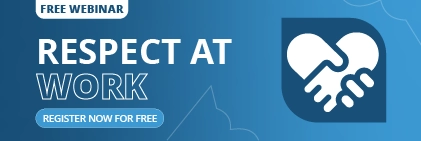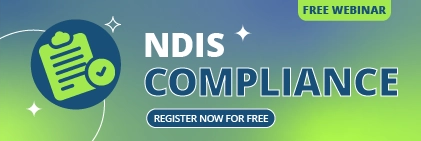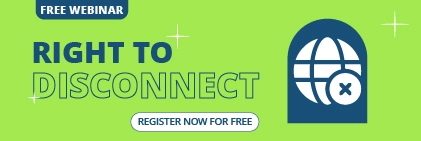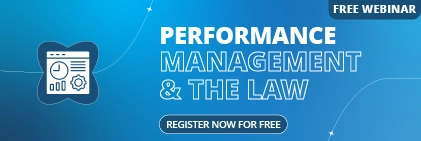Welcoming new employees to your organisation is one of your most critical responsibilities as a business or HR department.
While bringing fresh talent on board is exciting, ensuring their smooth integration into your company requires careful planning and execution. That’s where a comprehensive employee onboarding process becomes your key to success.
When you consider your organisation’s growth, the way you welcome and integrate new hires plays a crucial role in their future success—and ultimately, your company’s success.
Without a structured onboarding approach, new employees risk feeling lost, overwhelmed, or disconnected from your organisation’s mission and culture.
However, with well-planned onboarding checklists, you can transform this challenging transition period into a robust foundation for long-term employee engagement and productivity.
As an HR professional, you need a systematic approach to guide new hires through their crucial first days, weeks, and months. This comprehensive guide will equip you with everything you need to create and implement practical onboarding checklists for your organization.
What is Employee Onboarding?
Employee onboarding is more than just a new hire’s first-day orientation or paperwork completion. It’s a comprehensive process that covers all the activities and experiences you provide to help your new employees become fully integrated members of your organization.
This strategic process typically spans from when a candidate accepts your job offer to when they becomes a fully functioning team member.
When you implement an employee onboarding checklist, you create a structured pathway that helps transform promising candidates into productive, engaged employees.
This process involves everything from introducing company policies and procedures to fostering connections with team members and understanding their role within the larger organisational context.
Effective onboarding goes beyond basic orientation tasks. It includes helping new employees understand your company’s culture, values, and expectations.
You must ensure they have the right tools, access to necessary systems, and a clear understanding of their responsibilities. More importantly, it’s about making them feel welcomed, valued, and prepared to contribute meaningfully to your organisation’s success.
A well-designed onboarding process can last a few weeks to several months, depending on the role and your organisation’s needs.
During this time, you’ll guide new hires through various stages of integration, from completing initial paperwork and setting up workstations to establishing performance goals and building relationships with colleagues.
Following a structured employee onboarding checklist template ensures no critical steps are missed in this crucial transition period.
Remember, onboarding is an investment in your new hire’s future with your company.
When done right, it sets the foundation for employee satisfaction, productivity, and long-term retention.
What is an Employee Onboarding Checklist?
An employee onboarding checklist is your comprehensive roadmap for successfully integrating new hires into your organisation.
It’s a structured document outlining all the steps, tasks, and milestones you need to accomplish throughout the onboarding process.
In other words, it acts as your master plan, ensuring consistency and completeness in how you welcome and prepare every new employee for success in your organisation.
From essential paperwork to team introductions, from system access setup to training schedules – your employee onboarding checklist helps you track and manage every crucial element.
The beauty of an onboarding checklist lies in its versatility. You can break it down into different timeframes and categories, such as your pre-onboarding checklist for tasks that must be completed before the employee’s first day, first-week activities, and longer-term integration goals.
This systematic approach ensures that neither you nor your new hire misses any critical steps.
For your management team, an employee onboarding checklist provides clear guidance on their responsibilities in the onboarding process. It helps them understand their role in welcoming new team members, setting expectations, and supporting their integration into the team.
You might even include specific examples of employee onboarding checklists within your documentation to demonstrate best practices and successful approaches that have worked in the past.
A well-structured onboarding checklist keeps you organised and provides transparency to all parties involved in the onboarding process.
It sets clear expectations, establishes timelines, and creates accountability for both HR teams and department managers.
Most importantly, it helps ensure that your new employees receive a consistent, professional, and comprehensive introduction to your organisation, regardless of who’s managing their onboarding process.
Why is Having an Employee Onboarding Checklist Important
Creating a positive first impression and setting your new hires up for success isn’t just good practice – it’s essential for your organisation’s growth and stability.
When implementing an employee onboarding checklist, you invest in your company’s future success. Let’s explore the three key reasons why having a structured onboarding process is crucial for your organisation.
Improved Retention
Employee turnover is costly, both financially and culturally.
Using a comprehensive employee onboarding checklist template significantly increases your chances of retaining new talent.
Research shows that employees who experience a well-structured onboarding process are 58% more likely to stay with your organisation for three years or more.
Following a detailed onboarding checklist, you demonstrate to new hires that you’re invested in their success from day one. This structured approach helps them feel valued and supported, reducing the uncertainty and anxiety that often leads to early departures.
You create a strong foundation for long-term commitment to your organisation when you provide clear guidance, resources, and support through your onboarding process.
Increased Productivity
A systematic approach to onboarding, guided by an employee onboarding document checklist, dramatically reduces the time it takes for new hires to become productive team members.
Rather than leaving them to figure things out independently, your checklist ensures they receive all necessary training, tools, and information organisationally.
With a well-planned onboarding process, you can help new employees understand their roles more quickly and start contributing meaningfully to your organization sooner.
This structured approach means less time spent searching for basic information or navigating unfamiliar systems. Instead, your new hires can focus on learning their core responsibilities and adding value to their teams.
Better Company Culture
Your onboarding process sets the tone for how new employees perceive and integrate into your company culture.
An employee onboarding checklist helps ensure that cultural integration is prioritised alongside technical training and administrative tasks. When you consistently execute your onboarding process, you create a welcoming environment that reinforces your company’s values and expectations.
A strong onboarding program helps new hires build relationships with their colleagues, understand your company’s mission and values, and feel like part of the team. This cultural alignment leads to better collaboration, increased engagement, and a more positive workplace atmosphere.
Following your checklist ensures that every new employee receives the same warm welcome and cultural introduction, regardless of their role or department.
Benefits of Using an Employee Onboarding Checklist
There are a plethora of benefits to using an employee onboarding checklist. Let’s discuss the main ones.
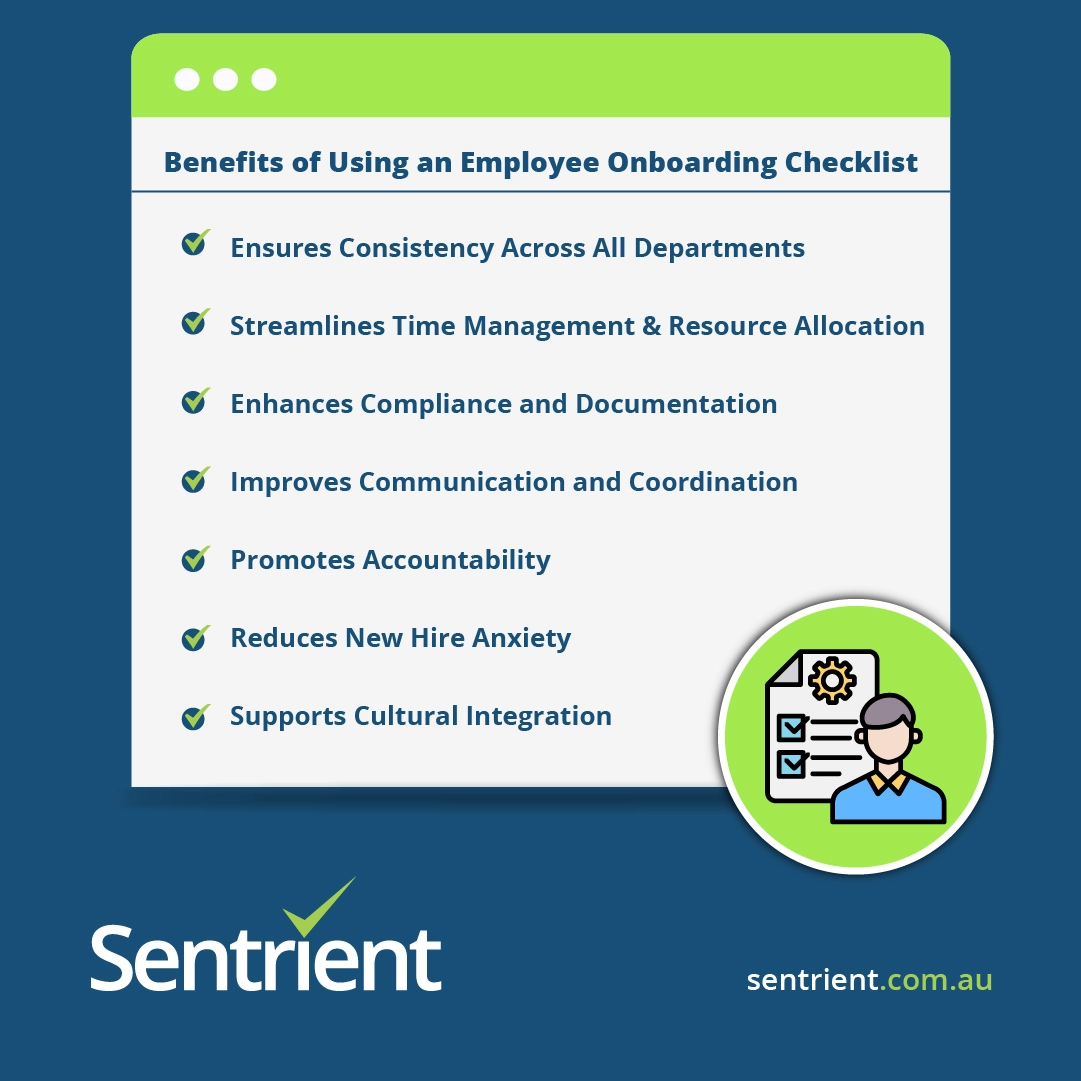
Ensures Consistency Across All Departments
Implementing an employee onboarding checklist brings uniformity to your onboarding process across all departments.
Every new employee receives the same comprehensive experience, whether joining the marketing team or warehouse.
When you follow an employee onboarding checklist template, you eliminate the risk of missing essential steps or varying standards being applied across different teams.
This standardisation becomes particularly valuable as your organisation grows and onboarding responsibilities are distributed among multiple stakeholders.
Streamlines Time Management and Resource Allocation
Time management becomes significantly more efficient when you have a structured roadmap.
Your HR teams can better coordinate with department managers, plan orientation sessions, and schedule necessary training.
Instead of juggling multiple tasks haphazardly, you can systematically work through each phase of the onboarding process with confidence and precision.
The structured timeline also helps you anticipate and prepare for upcoming onboarding activities, reducing last-minute rushes and ensuring a smoother experience for everyone involved.
Enhances Compliance and Documentation
With a detailed employee onboarding checklist, managing compliance requirements becomes seamless.
You can ensure all necessary paperwork is completed accurately and on time, from tax forms to policy acknowledgments.
This systematic approach helps maintain proper documentation for legal purposes and simplifies the audit process when needed. A comprehensive checklist also helps you stay current with changing regulations and requirements, as you can easily update your documentation procedures when necessary.
Additionally, it provides a clear paper trail that protects your organisation and your new employees by consistently meeting all legal and regulatory obligations.
Improves Communication and Coordination
Clear communication channels are established when everyone understands their role in the onboarding process.
Your employee onboarding checklist provides clear guidelines about responsibilities and expectations, while HR teams can easily monitor progress and promptly address any delays or issues.
This improved coordination extends to all stakeholders involved in the onboarding process, from IT departments setting up equipment to team leaders preparing training schedules.
The checklist is a central reference point that keeps everyone aligned and informed about their responsibilities and timelines. This clarity helps prevent miscommunications and ensures that all aspects of onboarding are handled efficiently and effectively.
Promotes Accountability
With clearly defined tasks and timelines, accountability becomes natural across your organization.
Each department and individual involved in the onboarding process knows precisely what they’re responsible for and when tasks must be completed. This clarity eliminates the “someone else will handle it” mentality and ensures that all aspects of onboarding receive proper attention.
The checklist also makes it easy to track progress and identify any bottlenecks or delays, allowing you to address issues promptly and maintain the momentum of the onboarding process.
Regular check-ins and progress reviews become more meaningful when everyone understands their responsibilities and can report on specific accomplishments.
Reduces New Hire Anxiety
Your comprehensive checklist helps reduce uncertainty for new employees by providing a clear roadmap of what to expect.
This transparency helps them feel more secure and supported as they navigate their first weeks in your organisation. Knowing that there’s a structured plan in place can significantly reduce the stress and anxiety that often accompanies starting a new job.
The checklist also helps new hires understand their progress through the onboarding process, giving them a sense of accomplishment as they complete each milestone.
This confidence-building approach helps them integrate more quickly and effectively into their new role and team.
Supports Cultural Integration
The checklist helps ensure that cultural integration isn’t overlooked amidst technical and administrative tasks.
You can systematically introduce company values, team dynamics, and workplace norms to help new employees feel connected to your organisation’s mission and culture.
This planned approach to cultural integration includes opportunities for social interaction, mentorship, and exposure to your organisation’s operations.
By incorporating cultural elements into your onboarding checklist, you help new hires understand not just what they need to do but how they can contribute to and thrive within your company culture.
What to Include in Your Employee Onboarding Checklist
Your onboarding process must be thorough and well-organised to ensure a smooth transition for new hires.
Let’s explore the essential components that should be included in your employee onboarding checklist.
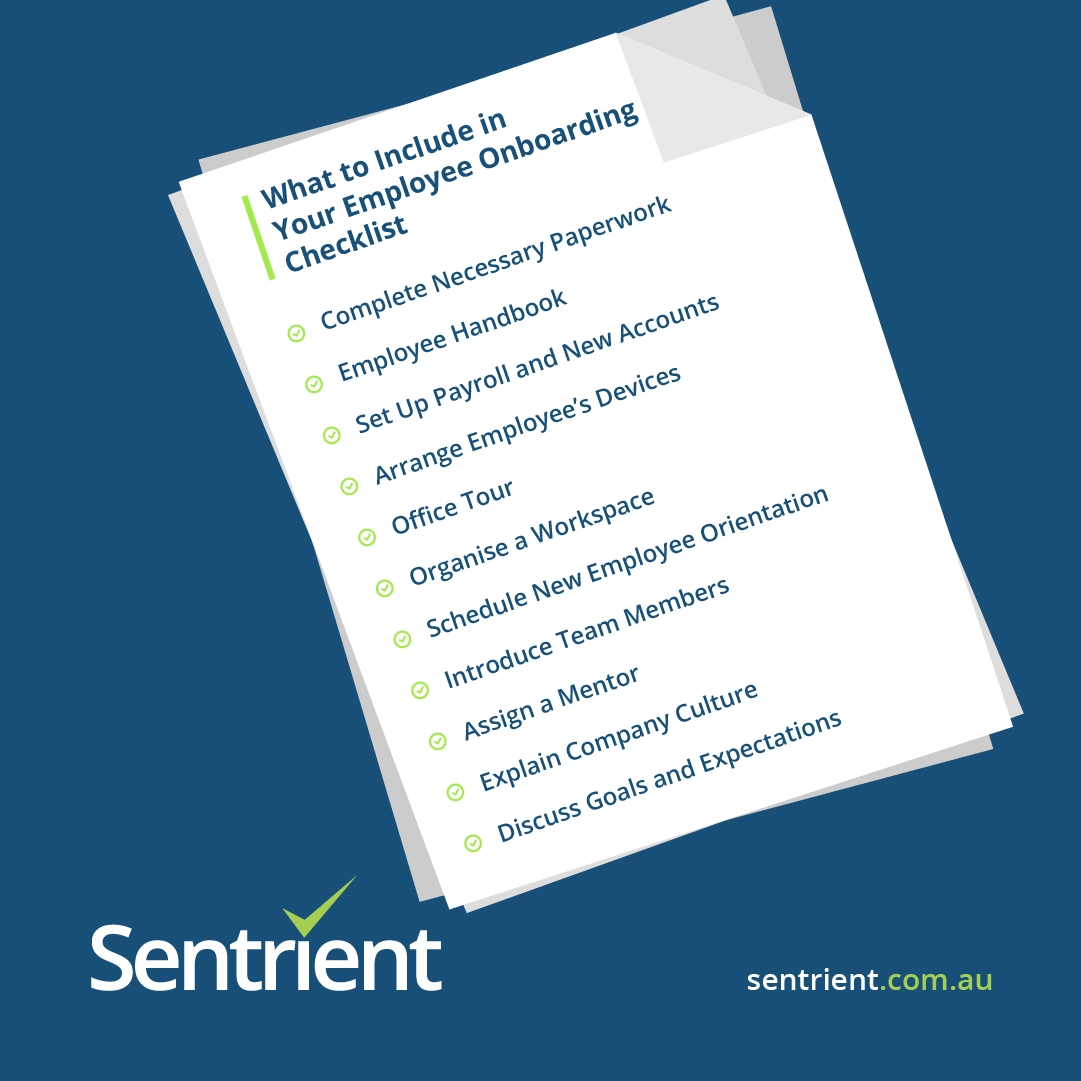
Complete Necessary Paperwork
The foundation of your employee onboarding checklist starts with essential paperwork.
This step involves collecting and processing all required documentation to establish employment legally and formally. You’ll need to ensure completion of tax forms, employment contracts, non-disclosure agreements, and other company-specific agreements should be prepared and signed.
Beyond the legal requirements, you’ll want to gather emergency contact information, direct deposit forms, and benefit enrolment paperwork.
Creating a systematic approach to collecting these documents helps prevent overlooking critical items and ensures compliance with employment regulations.
Remember to have all forms ready before the employee’s first day and provide clear instructions for completion. This preparation shows professionalism and prevents delays in processing essential employment documentation.
Employee Handbook
Your employee handbook is more than just a collection of policies – it’s a comprehensive guide that helps new hires understand your organisation’s operations, expectations, and culture.
When sharing the handbook, create a structured review process that allows employees to digest the information effectively. You need to include key policies regarding attendance, dress code, time off requests, and workplace conduct.
In addition, you should also highlight sections about company benefits, performance expectations, and career development opportunities.
Most importantly, document the employee’s receipt and acknowledgment of the handbook. This documentation should be included in their personnel file and can be referenced if policy questions arise.
Set Up Payroll and New Accounts
One of the most critical aspects of welcoming new employees is ensuring they can access necessary systems and receive compensation without issues.
For this reason, you must collect and verify all payroll information well before the first pay period. This includes processing tax forms, confirming banking details for direct deposit, and ensuring all salary-related documentation is accurately recorded in your payroll system.
Simultaneously, you must work with your IT department to establish all required accounts and system access.
New employees will need email accounts, access to communication platforms, and login credentials for any role-specific software they’ll be using. Create comprehensive guides with login information and basic instructions for navigating these essential systems.
Arrange Employee’s Devices
Setting up proper equipment and devices is crucial for enabling your new hire’s productivity from day one.
You need to determine which devices and tools they’ll need based on their role and responsibilities. This typically includes a computer or laptop, phone system, and other role-specific equipment.
To do this effectively, you must work closely with your IT department to ensure all devices are correctly configured with the necessary software, security protocols, and network access.
In addition, you should test all equipment thoroughly before the employee’s first day. This includes verifying that all software is installed correctly, that the email accounts function is correct, and that necessary permissions are granted.
This preparation helps prevent technical difficulties that could hinder their initial work experience.
Office Tour
A comprehensive office tour helps new employees feel comfortable in their work environment and understand how to navigate your workplace effectively.
You can start your office tour by touring essential locations like the workspace, restrooms, break rooms, and emergency exits. Show them where to find office supplies, printers, and other shared resources they’ll need to access regularly.
During the tour, introduce them to key personnel in different departments and explain the general layout of various teams. You should also point out collaborative spaces, meeting rooms, and quiet areas for focused work.
More importantly, you should remember to explain any office protocols, such as conference room booking systems or kitchen etiquette.
This orientation helps new hires feel more at home and reduces the anxiety of navigating an unfamiliar environment.
Organise a Workspace
Creating a welcoming and functional workspace demonstrates that you’ve thoughtfully prepared for your new employee’s arrival.
First, ensure their desk or office is clean, organised, and equipped with essential supplies like notebooks, pens, and any necessary reference materials. Next, you must set up their workstation ergonomically, with proper seating and equipment positioning to promote comfort and productivity.
Furthermore, you should consider preparing a welcome package at their desk that includes their security badge, business cards (if applicable), and any company-branded items.
Most importantly, you must include a list of essential phone extensions, contact information for key team members, and any department-specific resources they might need. This attention to detail helps create a positive first impression and shows that you value their addition to the team.
Schedule New Employee Orientation
A structured orientation program helps new hires understand your organisation’s big picture while learning about their roles.
You need to plan a comprehensive session that covers your company’s history, mission, values, and strategic objectives. In addition, you should include presentations from different department leaders who can explain how various teams contribute to the organisation’s success.
Furthermore, you need to use this time to review important company policies, safety procedures, and compliance requirements in detail. Also, you should schedule focused training sessions for specific tools or processes they must master.
Lastly, the orientation should be broken down into manageable segments over several days to prevent information overload.
Introduce Team Members
How you handle team introductions can significantly impact how quickly your new hire integrates into your organisation.
Instead of rushing through quick introductions, create meaningful opportunities for connection by scheduling brief but focused meet-and-greet sessions with immediate team members.
During these interactions, provide context about each team member’s role and how they’ll collaborate with the new hire.
Additionally, you should consider organising a team lunch or informal coffee break during the first week to facilitate more natural conversations. These casual settings often lead to more meaningful connections than formal meetings.
Before your new employee arrives, brief existing team members about the new hire’s role and responsibilities.
This preparation ensures everyone understands how the new team member will contribute to the team’s success and enables them to provide relevant support and information during initial interactions.
Assign a Mentor
A well-chosen mentor can dramatically improve your new hire’s transition into your organisation.
However, you need to select someone who excels in their role, demonstrates strong communication skills, and embodies your company values. Your mentor should be prepared to share insights about formal processes and unwritten organisational norms that help new employees navigate the workplace successfully.
In addition, you must structure the mentorship program by establishing clear expectations and holding regular check-in meetings during the first few months. Your employee onboarding checklist should include specific touchpoints for mentor-mentee interactions, ensuring consistent support throughout onboarding.
The mentor is a trusted guide who can answer questions, provide feedback, and help the new employee build confidence in their role.
Explain Company Culture
Your organisation’s culture shapes how work gets done and how people interact within your company.
That’s why you need to take time to explain both the formal and informal aspects of your workplace culture. Not only that, but you should also share specific examples of how your company values translate into daily actions and decisions.
You also need to consider helping new employees understand your organisation’s unique communication preferences, meeting protocols, and collaboration styles.
Beyond simply stating your mission and values, provide concrete examples of how these principles guide decision-making and behaviour within your company. Discuss typical work patterns, flexibility policies, and social norms that might not be documented in their handbook but are essential for successful integration into your workplace community.
This deeper understanding of your culture helps new employees align their work style with organisational expectations.
Discuss Goals and Expectations
Clear goals and expectations provide new employees with a roadmap for success.
You must begin this discussion by thoroughly reviewing their job description and explaining how their responsibilities connect to broader team and organisational objectives.
Using your employee onboarding checklist as a guide, establish specific, measurable goals for their first three months.
You should also create a structured plan that outlines learning objectives and performance targets for their first 30, 60, and 90 days. While at it, be explicit about how success will be measured and what resources are available to support their achievement of these goals.
Consider scheduling regular check-ins to monitor progress and provide feedback, ensuring they stay on track during their initial months with your organisation.
This forward-looking conversation demonstrates your commitment to their growth and helps them envision a long-term future with your organisation.
Employee Onboarding Welcome Email Checklist
The welcome email is the first touchpoint in your new hire’s journey with your organisation.
Creating a comprehensive yet welcoming email sets the right tone and ensures your new employee has all the information they need for a smooth start.
Here’s a detailed checklist of what to include in your onboarding welcome email:
Opening and Introduction
- Personalised greeting using the employee’s name and specific role
- Express enthusiasm about them joining the team
- Confirm start date, time, and location
- A brief overview of what to expect from the onboarding process
First Day Instructions
- Parking information and building access details
- Preferred entrance and check-in location
- Security protocols or badge pickup procedures
- Name of the person greeting them
- First-day schedule overview
- Dress code requirements
- Lunch arrangements for the first day
Required Documents
- Photo ID
- Employment verification documents
- Banking information for direct deposit
- Completed tax forms (if not already submitted)
- Professional certifications (if applicable)
- Emergency contact information
Pre-Start Tasks
- Forms or documents requiring completion before day one
- Links to any online training modules
- Instructions for setting up company accounts
- Request to review preliminary materials
- Deadline reminders for any pre-work activities
- Instructions for completing virtual paperwork
Contact Information
- Direct supervisor’s name and contact details
- HR representative’s contact information
- IT support contact for system access issues
- Mentor’s name and contact details (if assigned)
- The department head’s contact information
Attachments to Include
- Employee onboarding checklist
- New hire paperwork package
- Employee handbook
- Company policies overview
- Team organization chart
Employee Onboarding Checklist
A comprehensive employee onboarding checklist ensures you collect and process all necessary paperwork efficiently.
Here’s a detailed breakdown of the documents you need to organise:
Legal and Employment Documentation
- Tax Form
- An employment contract or offer letter
- Non-disclosure agreements (NDAs)
- Non-compete agreements (if applicable)
- Intellectual property agreements
- Drug testing consent forms (if required)
Company Policy Documents
- Employee handbook acknowledgment form
- Code of Conduct acknowledgment
- IT security and acceptable use policies
- Social media policy acknowledgment
- Remote work policies (if applicable)
- Anti-harassment policy acknowledgment
- Workplace violence prevention policy
Payroll and Financial Documents
- Direct deposit authorisation
- Bank account information
- Travel policy acknowledgment
- Compensation agreement
- Bonus structure documentation
- Commission agreement (if applicable)
Personal Information Forms
- Emergency contact information
- Personal data sheet
- Professional license copies (if required)
- Educational certificates
- Training certifications
- Vehicle registration (if a company car is provided)
- Parking permit application
- Building access card request
Pre-Onboarding Checklist
The period between offer acceptance and the first day is crucial for setting up your new hire for success.
A thorough pre-onboarding checklist helps you prepare everything your new employee needs while creating excitement about joining your organisation.
Here’s a comprehensive breakdown of tasks to complete before your new hire’s first day:
Administrative Preparation
- Process signed offer letter and employment contract
- Create employee file and ID number
- Add to the payroll system and benefits portal
- Generate required employment paperwork
- Schedule orientation sessions
- Set up parking arrangements
Technology Setup
- Order necessary computer equipment
- Configure email accounts and aliases
- Set up a phone system and voicemail (if required)
- Create login credentials for all required systems
- Install necessary software and applications
- Set up printer and scanner access
Workspace Preparation
- Clean and organise workspace
- Order office supplies and equipment
- Set up desk, chair, and storage
- Install necessary hardware
- Check lighting and ergonomics
- Place employee welcome package
Team and Training Preparation
- Notify team members of new hire
- Select and brief mentor
- Schedule team introductions
- Plan first-day agenda
- Prepare training materials
- Set up initial meetings
- Create training schedule
- Coordinate team welcome activities
First Day Planning
- Create a detailed first-day schedule
- Arrange welcome breakfast/lunch
- Prepare building tour route
- Coordinate greeting procedure
- Plan team introduction timing
- Plan end-of-day check-in
Documentation Organisation
- Gather all necessary forms
- Prepare welcome packet
- Compile policy documents
- Create access cards/badges
- Prepare training manuals
First-Day Employee Onboarding Checklist
The first day sets the tone for your new employee’s experience with your organisation.
A well-planned first day helps ease anxiety and creates a positive impression.
Here’s a detailed checklist to ensure your new hire’s first day is organised, welcoming, and productive:
Early Morning Preparation
- Have workspace fully set up and clean
- Place the welcome package on the desk
- Test all technology and systems
- Prepare security badge/access card
- Set up welcome breakfast/coffee
- Have all paperwork organised
- Ensure mentor/buddy is prepared
- Double-check schedule timing
- Post a welcome sign at the workspace
Welcome and Introduction
- Greet the employee at the designated entrance
- Offer coffee/water/refreshments
- Give a brief building tour
- Show them their workspace
- Introduce immediate team members
- Present welcome package
- Review first-day schedule
- Review first-day schedule
Essential Paperwork
- Complete remaining new hire documents
- Review and sign company policies
- Process identification documents
- Collect banking information
- Complete benefit enrolments
- Set up payroll information
Workspace Orientation
- Review office supplies
- Explain desk organisation
- Explain desk organisation
- Show storage locations
- Point outbreak areas
- Show conference rooms
- Locate office resources
Team Integration Activities
- Team welcome lunch/coffee
- Department introductions
- Meet with the direct supervisor
- Connect with an assigned mentor
- Brief team culture overview
- Share team schedule/calendar
- Plan next-day activities
End-of-Day Processes
- Review questions and concerns
- Confirm the next day’s schedule
- Check all system access
- Ensure paperwork completion
- Schedule follow-up meetings
- Provide take-home materials
First Week Employee Onboarding Checklist
Following the crucial first day, the remainder of the first week is vital in helping your new hire settle into their role and understand your organisation’s operations.
Use this comprehensive checklist to ensure a productive and engaging first week that builds on the foundation established during day one.
Monday (First Day Review)
- Complete any unfinished paperwork
- Ensure all logins are working properly
- Review week’s schedule in detail
- Set up remaining software tools
- Establish communication preferences
- Follow up on any first-day questions
- Begin initial training modules
- Schedule key stakeholder meetings
- Review team projects and priorities
Tuesday (Role and Responsibilities)
- Deep dive into job responsibilities
- Review performance expectations
- Discuss short-term objectives
- Begin role-specific training
- Introduce project tools
- Set up recurring team meetings
- Share departmental calendars
- Review reporting structures
- Explain workflow processes
Wednesday (Systems and Processes)
- Continue system-specific training
- Continue system-specific training
- Practice using key software
- Review documentation procedures
- Understand approval processes
- Learn time-tracking systems
- Study quality control measures
- Explore company resources
- Practice common workflows
Thursday (Team Integration)
- Participate in team meetings
- Shadow experienced colleagues
- Begin handling basic tasks
- Join project discussions
- Learn team collaboration tools
- Review communication protocols
- Understand escalation procedures
- Practice daily responsibilities
- Connect with cross-functional teams
Friday (Progress Review)
- Meet with supervisor for feedback
- Review week’s learning progress
- Address outstanding questions
- Plan next week’s objectives
- Check documentation completion
- Confirm training schedule
- Set up performance goals
- Schedule regular check-ins
- Share initial impressions
Daily Tasks Throughout Week
- Morning check-ins with the mentor
- Practice using new systems
- Document questions and concerns
- Review training materials
- Connect with team members
- Complete assigned learning tasks
- Process relevant paperwork
- Update progress tracking
- End-of-day debriefs
30 Days Employee Onboarding Checklist
A new hire’s first month is critical for establishing strong foundations and ensuring they progress toward full productivity.
This comprehensive 30-day checklist helps track their development and integration into your organisation while following your employee onboarding checklist.
Week 1-2 Progress Review
- Week 1-2 Progress Review
- Check system and tool proficiency
- Assess basic task performance
- Monitor team integration progress
- Evaluate communication effectiveness
- Track project involvement
- Gauge policy understanding
- Review security compliance
- Measure role comprehension
Performance and Goals
- Set clear 30/60/90-day goals
- Establish performance metrics
- Define success indicators
- Create development plan
- Schedule regular check-ins
- Set learning objectives
- Outline skill development paths
- Discuss career aspirations
- Plan ongoing training
Communication and Feedback
- Schedule weekly supervisor meetings
- Conduct mentor check-ins
- Gather peer feedback
- Address concerns promptly
- Share progress updates
- Discuss challenges
- Provide performance feedback
- Assess communication style
- Plan future development
Project Involvement
- Assign initial projects
- Set project expectations
- Review deliverables
- Monitor progress
- Provide guidance
- Evaluate outcomes
- Increase responsibilities
- Plan future assignments
- Track contributions
End-of-Month Evaluation
- Review 30-day goals
- Assess skill development
- Evaluate role comfort
- Check productivity levels
- Gauge team integration
- Plan next month’s objectives
- Address ongoing needs
- Celebrate achievements
- Set future expectations
90 Days Employee Onboarding Checklist
The 90-day mark represents a significant milestone in your new employee’s journey, typically signalling their full integration into your organization.
This comprehensive checklist helps ensure they’ve successfully transitioned from new hires to fully productive team members while following your employee onboarding checklist.
30-60 Day Review Phase
- Evaluate performance against initial goals
- Review project contributions
- Assess team integration success
- Check productivity levels
- Monitor skill development
- Gather peer feedback
- Track system proficiency
- Review learning progress
- Measure role competency
60-90 Day Development Phase
- Increase project responsibilities
- Expand role scope
- Deepen technical expertise
- Build advanced skills
- Strengthen team relationships
- Enhance decision-making abilities
- Develop leadership capabilities
- Improve problem-solving skills
- Foster innovation mindset
Professional Growth
- Set long-term career goals
- Plan skill enhancement opportunities
- Identify training needs
- Discuss advancement paths
- Review certification progress
- Define development timeline
- Explore mentoring opportunities
- Consider specialised training
- Plan future responsibilities
Performance Evaluation
- Conduct a formal performance review
- Set new performance targets
- Review goal achievement
- Assess productivity metrics
- Evaluate work quality
- Discuss areas for improvement
- Recognise accomplishments
- Plan future objectives
- Adjust role expectations
Project Management
- Review project outcomes
- Assess initiative levels
- Evaluate problem-solving abilities
- Check decision-making skills
- Monitor time management
- Review resource utilisation
- Assess planning capabilities
- Evaluate risk management
- Check quality standards
90-Day Completion Milestone
- Complete final evaluation
- Set future performance goals
- Plan ongoing development
- Review compensation alignment
- Discuss career progression
- Celebrate achievements
- Outline next steps
- Gather comprehensive feedback
- Plan future success
Remote Employee Onboarding Checklist
Onboarding remote employees presents unique challenges that require special attention to ensure successful integration into your team.
This tailored employee onboarding checklist template helps create a comprehensive, engaging, effective virtual onboarding experience.
Pre-First Day Technology Setup
- Ship laptop and necessary equipment
- Provide detailed setup instructions
- Configure VPN access
- Set up email and communication tools
- Create necessary software accounts
- Send login credentials securely
- Test video conferencing tools
- Test video conferencing tools
- Ensure cybersecurity measures
Documentation and Paperwork
- Send digital document package
- Set up an e-signature system
- Share digital employee handbook
- Send benefits enrolment forms
- Include remote work policies
- Provide IT support contacts
Virtual Welcome Process
- Schedule a video welcome call
- Send the virtual welcome package
- Create a digital team introduction
- Plan a virtual office tour
- Share organizational chart
- Provide virtual mentor contact
- Schedule team meet-and-greets
- Plan digital culture presentation
- Create a virtual buddy system
Communication Setup
- Establish preferred communication channels
- Set up instant messaging platforms
- Configure project management tools
- Share team availability calendars
- Define response time expectations
Remote Training Program
- Develop a virtual training schedule
- Create online learning modules
- Set up screen-sharing sessions
- Provide recorded tutorials
- Schedule live training calls
- Plan progress check-ins
- Establish learning goals
Virtual Team Integration
- Schedule regular team meetings
- Create virtual social events
- Plan informal coffee chats
- Set up a mentorship program
- Organise team-building activities
- Share team collaboration norms
Performance Management
- Set clear remote work expectations
- Establish productivity metrics
- Create goal-tracking system
- Schedule regular check-ins
- Define success indicators
- Plan progress reviews
- Set communication expectations
Work-Life Balance Support
- Share time management tips
- Discuss working hours
- Establish boundaries
- Provide wellness resources
- Share break schedules
- Discuss home office setup
- Address potential challenges
Onboarding Checklist for Managers
As a manager, your role in the onboarding process is crucial for ensuring the success of your new team members.
This employee onboarding checklist for managers provides a comprehensive framework to effectively guide new hires through their transition while maintaining team productivity and engagement.
Pre-Arrival Preparation
- Review role requirements and expectations
- Prepare a detailed first-week schedule
- Configure necessary system access
- Set up workstation and equipment
- Brief existing team members
- Plan initial projects and tasks
- Organise training materials
- Select and brief team mentor
- Create goal-setting framework
First Day Leadership
- Personally welcome a new hire
- Give a comprehensive team introduction
- Review role expectations
- Explain team structure
- Share communication preferences
- Discuss management style
- Set initial priorities
- Review first-week schedule
- Establish check-in schedule
First Week Guidance
- Monitor initial progress
- Provide necessary resources
- Facilitate team integration
- Review basic procedures
- Address early concerns
- Guide priority setting
- Ensure proper training
- Check system access
- Evaluate early adaptation
30-Day Leadership Tasks
- Review performance progress
- Adjust workload as needed
- Assess training effectiveness
- Provide detailed feedback
- Monitor team integration
- Evaluate skill development
- Address learning gaps
- Set clear expectations
- Plan development path
60-Day Development Focus
- Increase responsibility levels
- Review project contributions
- Assess independence level
- Monitor productivity
- Evaluate team dynamics
- Check resource utilization
- Guide professional growth
- Address challenges
- Plan skill enhancement
90-Day Evaluation Process
- Conduct formal review
- Set long-term goals
- Assess overall performance
- Review team feedback
- Plan future development
- Discuss career path
- Evaluate cultural fit
- Address any concerns
- Celebrate achievements
Ongoing Management Responsibilities
- Schedule regular one-on-ones
- Provide consistent feedback
- Monitor workload balance
- Support professional growth
- Address performance issues
- Recognise achievements
- Foster team integration
- Guide skill development
- Maintain open communication
Conclusion
A comprehensive employee onboarding checklist is essential for creating a positive, productive start for your new hires.
A well-structured onboarding process ensures compliance and efficiency and significantly impacts employee engagement, retention, and long-term success within your organisation.
By following these detailed checklists, from pre-onboarding preparations through the crucial first 90 days, you create a consistent, thorough experience that benefits both your organisation and your new employees.
Remember that each phase of the onboarding process plays a vital role in helping new hires transition from enthusiastic newcomers to fully integrated, productive team members.
Want to streamline your onboarding process even further?
Sentrient’s employee onboarding software offers a comprehensive solution that helps you manage every aspect of your onboarding process efficiently.
Experience how Sentrient can transform your onboarding process from a series of tasks into a strategic advantage for your organisation.
FAQs
1. What is the onboarding process in HR?
The onboarding process in HR represents a structured approach to welcoming and integrating new employees into your organisation. This comprehensive process begins when a candidate accepts your job offer and extends through their first few months.
Rather than just a single day of orientation, it encompasses a strategic series of activities designed to help new hires become productive and engaged members of your team.
2. What is Human Resources Business Partners’ (HRBP) role in onboarding?
HRBPs serve as strategic advisors throughout the onboarding process, working closely with hiring managers and department leaders to create effective integration plans for new employees. They take a big-picture view of onboarding, ensuring that your processes align with broader organisational objectives while meeting the specific needs of different departments and roles.
3. Who in HR is responsible for onboarding?
Onboarding responsibility typically spans various roles within your HR department, creating a collaborative effort to ensure new hire success. While specific titles and responsibilities may vary by organisation, the process usually involves several key players working together to create a comprehensive onboarding experience.
Read More About Onboarding Management System :
- Factors To Consider When Planning The Length Of Your Employee Onboarding Process
- What is a Human Resource Information System (HRIS)?
- Benefits Of Having HR Management Software In Your Organisation
- How to Handle Employee Policy Issues: FAQ for HR Managers
- Key Factors to Address in HR Risk Management for Modern Workplaces
